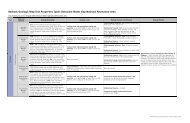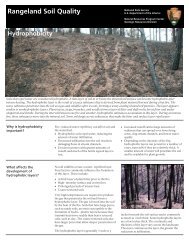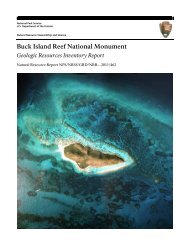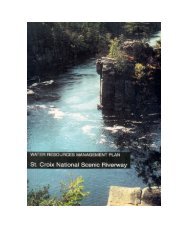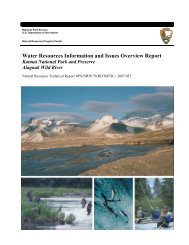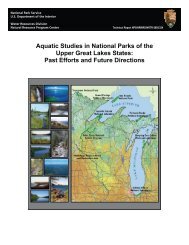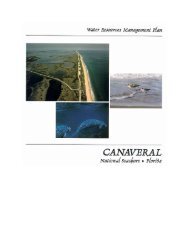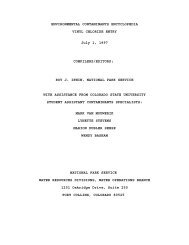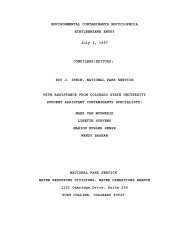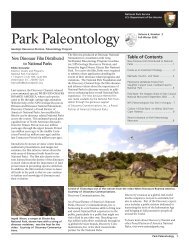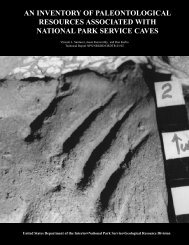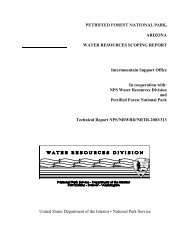Naphthalene, C1 - National Park Service
Naphthalene, C1 - National Park Service
Naphthalene, C1 - National Park Service
Create successful ePaper yourself
Turn your PDF publications into a flip-book with our unique Google optimized e-Paper software.
spill. Concentrations in 1) unweathered oil from the tanker itself<br />
(March 1989), 2) oil skimmed from the water immediately after the<br />
spill and held in the skimmer barge for about 90 days (July 1989),<br />
and 3) weathered oil from Prince William Sound shorelines (May<br />
1989) were: 1307, 150, and 52 ug/g oil sampled, respectively [790;<br />
Reprinted with permission from Environmental Toxicology and<br />
Chemistry, Vol.14(11), W.A. Stubblefield, G.A. Hancock, W.H. Ford,<br />
and R.K. Ringer, "Acute and Subchronic Toxicity of Naturally<br />
Weathered Exxon Valdez Crude Oil in Mallards and Ferrets."<br />
Copyright 1995 SETAC].<br />
<strong>C1</strong>-naphthalene content in one fresh sample of NSFO (Fuel Oil<br />
5, Chuck Rafkind, <strong>National</strong> <strong>Park</strong> <strong>Service</strong>, Personal Communication,<br />
1996): 4086.9 ng/mg (ppm).<br />
<strong>C1</strong>-naphthalene content in one sample of groundwater subjected<br />
to long term contamination of NSFO (Fuel Oil 5), possibly mixed<br />
with some JP-4, motorgas, and JP-8, Colonial <strong>National</strong> Historical<br />
<strong>Park</strong> Groundwater Site MW-10 (Chuck Rafkind, <strong>National</strong> <strong>Park</strong> <strong>Service</strong>,<br />
Personal Communication, 1996): 2463.7 ng/L (ppt).<br />
NOTE: the above two PAH concentrations were analyzed by a<br />
GC/MS/SIM NOAA protocol [828] modified with methylene chloride<br />
extraction for use with water samples (Guy Denoux, Geochemical and<br />
Environmental Research Group, Texas A&M University, personal<br />
communication 1996).<br />
Details of naphthalene content (mg/kg or ppm) in one fresh<br />
sample of Exxon Valdez Crude Oil [971]:<br />
Note: these values are wet weight (Jerry Neff,<br />
Battelle Ocean Sciences, Duxbury, MA, personal<br />
communication 1996):<br />
<strong>Naphthalene</strong>: 622 mg/kg = ppm<br />
<strong>C1</strong>-<strong>Naphthalene</strong>: 1400 mg/kg = ppm<br />
C2-<strong>Naphthalene</strong>: 1780 mg/kg = ppm<br />
C3-<strong>Naphthalene</strong>: 1410 mg/kg = ppm<br />
C4-<strong>Naphthalene</strong>: 696 mg/kg = ppm<br />
Details of naphthalene content (mg/kg or ppm) in salmon<br />
carcass (fatty viscera removed, so the concentrations may have<br />
been higher from whole body samples) from Snug Harbor, Alaska,<br />
an area heavily oiled by the Exxon Valdez Crude Oil, 4/15/89<br />
[971]:<br />
Note: Concurrent measurements of water quality, as well<br />
as equilibrium partitioning estimates of water quality<br />
based on concentrations in fish and mussels, both confirm<br />
that PAH concentrations did not exceed water quality<br />
criteria at the time these concentrations were measured<br />
in fish tissues [971]. These values are wet weight (Jerry<br />
Neff, Battelle Ocean Sciences, Duxbury, MA, personal<br />
communication 1996):<br />
<strong>Naphthalene</strong>: 7.15 ug/kg = ppb



